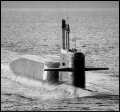AlmightyTallest
Posts: 279
Joined: 2/25/2014
Status: offline

|
quote:
The DU is probably an attempt to get higher Muzzle velocity, not sure in this application.
The tighter accuracy and probably the DU or at least tungsten, are of good use in the latest use of these systems (both Phalanx and Goalkeeper), knocking down incoming mortar and ballistic rocket rounds.
I can actually answer some of these questions for you guys.
For the use of DU or today Tungsten in the 20mm Phalanx, with the main threat being a Supersonic AShCM, the idea is that a oncoming penetrating round will pass through much of the missile, without breaking it into many high speed pieces. This is important, the main consideration with Phalanx was that engaging such a fast target at insufficient ranges would still put the targeted ship at risk because of the high energy of the leftover pieces of cruise missile if it broke apart. The Tungsten penetrator in the Block 1B is sub caliber, and higher velocity for shipboard use to help extend range.
If you have high velocity tungsten penetrating round that passes lengthwise through the cruise missiles systems, a single round could hit the ASM's radar, avionics, flight control systems, warhead, engine, etc. making it unflyable in one large piece which was preferable to breaking it up and having the pieces hit you.
For the C-RAM system as the video Gunner98 shows, these rounds aren't the same as those used on ships, they are HE and HEI, with a self destruct at a certain range to limit danger to personnel on the ground. These are used to break up the smaller incoming mortar and other artillery rounds while defending a base.
quote:
Advantage of tighter grouping is ammo conservation but you need everything spot on to actually hit.
Ammo conservation is one thing, but having your rounds tighter at close range and scatter at a further range allows you to engage at longer ranges. If my Phalanx 1B has 0.8 mil dispersion, and I'm firing at an anti-ship missile that's only 14" wide it gives me a better chance of hitting it further out, if my other systems are working to make the rounds connect.
Contrast that with an AK-630 with 10.3 mils dispersion trying to hit a harpoon missile at 530+ miles per hour that's only 13.5" frontal cross section.
My head hurts, but what is the dispersion at 1,000 meters with a weapon that is 10.3 mils?
Another video, this was an actual insurgent attack on a US base, three of the C-RAM's go into action shooting down multiple incoming rounds, the gentleman waking everyone up and screaming for HE is attempting to get the on base batteries ready to counter the threat, warning for strong language.
The alarm sound is from the radar's detecting an incoming threat and warning people to take cover and stay clear of the CIWS. It has saved lives in actual use.
https://www.youtube.com/watch?v=XceGKHATcYE
Another one, no warning when the Phalanx went active, at 11 or 12 seconds in, the quick flash near the center of the screen is the destroyed round.
https://www.youtube.com/watch?v=lY1NErClX1g
British friends watching the Cram take on a few incoming rounds. I know they laugh when they see these go off, but it makes the hair stand up on the back of my neck knowing what it means.
https://www.youtube.com/watch?v=GRpDdGMpgBI
< Message edited by AlmightyTallest -- 6/26/2014 4:27:17 PM >
|
 Printable Version
Printable Version












 New Messages
New Messages No New Messages
No New Messages Hot Topic w/ New Messages
Hot Topic w/ New Messages Hot Topic w/o New Messages
Hot Topic w/o New Messages Locked w/ New Messages
Locked w/ New Messages Locked w/o New Messages
Locked w/o New Messages Post New Thread
Post New Thread